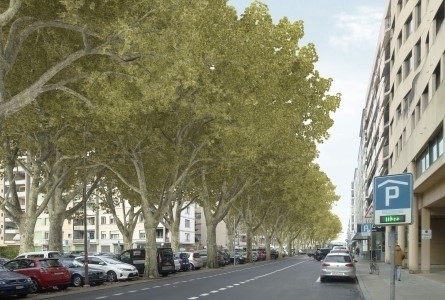To combat heat islands and foster biodiversity, the City of Geneva is introducing an original project of abandoning the practice of pruning its sculpted trees. Of the 1,370 trees concerned, 900 of them currently subject to “cat’s head” pruning will soon be allowed to take a semi-free form. This conversion will increase both the shade these trees offer and the extent of natural habitats for fauna.
In order to mitigate the effects of summer heatwaves and contribute to the development of biodiversity, the City of Geneva is introducing an original project of gradually abandoning the practice of pruning its sculpted trees.
Following a pilot phase launched last winter and a study conducted to establish the state of health of the 1,370 specimens concerned, the conversion of trees subject to “cat’s head” pruning into a semi-free form has now been formally introduced by the Parks and Gardens Department (SEVE).
Inherited from an aesthetic tradition dating back to the 19th century illustrating man’s desire to conquer nature, “cat’s head pruning” is a form of annual maintenance pruning, which aims to retain a limited volume and/or a particular shape of tree. “Today, on the contrary, our role is to help nature reassert its rights. Against the backdrop of climate emergency, these practices from the past must be abandoned. It is something of a revolution, as we are breaking with an age-old tradition dating back to when Geneva was an urban island surrounded by nature,” explains Mr Alfonso Gomez, Executive Councillor responsible for the environment.
Maximum tree cover
At the end of the conversion phase, which will take about 7 years to switch from the so-called “sculpted” form to a “semi-free” form, abandoning this type of pruning will result in an average increase in tree cover of 250%. This increase is all the more significant as the majority of the trees concerned are located in highly urbanised neighbourhoods. The expansion of the crowns of the trees will help increase not only the amount of shade in the sectors concerned but also the freshness and humidity they generate, thanks to the process of photosynthesis.
The increased foliage of the trees will also help combat pollution through enhanced filtering of the air while fostering the development of biodiversity by creating new habitats for a whole host of species that are dependent on trees. “While conversion projects have been implemented in a number of different cities – and in particular Paris and Strasbourg – on specific and clearly demarcated sites, the City of Geneva will, to the best of our knowledge, be the first municipality in Europe to initiate such a project across its territory as a whole,” continues Mr Gomez.
A step-by-step process
The health study found that of the 1,370 trees concerned, some 900 trees accounting for 66% of the total were sufficiently healthy to be good candidates for conversion. The conversion phase will require close accompaniment of each tree, in particular to teach them how to carry their branches. Involving major investment in terms of human resources and training for the pruning teams, who will need to develop new intervention and climbing techniques, the project will be implemented in several steps.
During the current season, 100 trees on 5 sites have been selected to launched the process – on rue du Vélodrome (11 plane trees), rue Dancet (50 plane trees), boulevard de la Cluse (13 lime trees and 5 maples), place Lise-Girardin (4 plane trees) and rue du Mont-Blanc (17 hornbeams). With a further 800 trees to be converted, the project will be staggered over time until 2026. As for the 500 trees which cannot be converted, they will be pruned every other winter in order to optimise the increase in foliage and free up resources. Newly planted trees will no longer be subject to “cat’s head” pruning. This new practice represents a major change in terms of tree management and is a large-scale project for the Parks and Gardens Department.
Inspiring other players
Increasing the canopy from 21% to 30% across the municipality is a bold objective incorporated into the Executive Council’s legislature programme. To achieve this objective, other measures have been introduced, including replacing each tree felled with three new specimens and creating urban micro-forests.
With this innovative project of reducing and abandoning pruning, the City of Geneva hopes to inspire authorities, home owners and other municipalities to contribute to the global increase in the surface area of urban foliage. All the forces concerned must be mobilised to combat climate change effectively and improve the quality of life in the city.
Contact
Vaucher Anna
Département des finances, de l'environnement et du logement
Collaboratrice personnelle
5, rue de l'Hôtel-de-Ville
1204
Genève
Suisse
Article modifié le 21.03.2023 à 18:21

